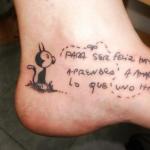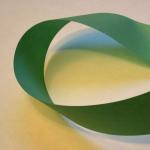How to make a peacock from bottles. Master class: DIY peacock made from plastic bottles
Since ancient times, the peacock has been considered the bird of kings in many nationalities. It represents nobility, glory, beauty and joy. or a balcony with an artificial peacock, you will fill the atmosphere with positive energy.
Bright and colorful appearance This bird attracts admiring glances and causes delight. If you want to diversify your usual environment, it will be useful for you to learn how to make a peacock out of a plastic bottle with your own hands.
Read also:
Where to start?
Feathers can be made from plastic bottles, you will need quite a lot of them. To ensure that their shape and dimensions are different, make blanks of different sizes. How fluffy the feathers will be depends on the width of the strips into which you will cut the parts. Feathers must be different sizes, for convenience they can be sorted into packages.
The body can be made of synthetic foam. It is easy to use and does not break. Select in advance a beautiful post on which the bird will be attached.

For the beak A red plastic bottle will come in handy. Using a thin black marker, draw the contours of the beak so as not to spoil the material.
In order for the breast to be colorful and bright, it must be covered with plastic of all colors, and then the feathers must be attached step by step. A glue gun equipped with silicone rods will do the job perfectly. When attaching feathers, you need to swap parts of different colors and sizes.
Peacock's back should be covered with longer and more voluminous feathers. To make a tuft, the material must be cut into very thin strips. The peacock must be completely covered with feathers, so you need to carefully ensure that there are no uncovered areas of foam.
Glue the blanks onto the neck, moving to the head. If before you didn’t know how to make a bird out of a plastic bottle, then at this stage of work you will begin to understand the intricacies of this process. Now the peacock begins to acquire a beautiful appearance.

Details
Next step - eye decoration. Making them depends on your imagination. You can use any available materials - beads, rhinestones, seed beads, buttons.
Decoration summer cottage original decorative items Lately has gained extraordinary popularity. Crafts made from bottles occupy a leading position in budget landscape design. Durable material retains its original shape for a long period of time, is affordable and incredibly functional. Detailed description the process of how to make a peacock from plastic bottles will help to realize interesting idea into reality on your own.
Available materials
The peacock is considered a noble bird that adorned the royal gardens for a long time. To decorate your own plot with a symbol of happiness, first of all you will need a lot of patience and free time. Therefore, it is better to start making a peacock, or at least its individual parts, in late autumn, when the main work on the plot has already been completed.
There are several options for making peacocks from plastic containers. Some craftsmen use foam plastic as a basis, decorating it with feathers cut from bottles. Others make the entire frame from plastic containers. Everyone chooses a method individually, depending on their own experience.
For our peacock you will need to prepare:
- the function of the body is performed by a plastic canister with a volume of 10 liters;
- PVC pipes are used as legs;
- for fastening together individual elements peacock will need thick wire;
- metal mesh as a base for the wings and tail of a peacock made from bottles measuring 0.5 x 1.5 m;
- foam for the head of the royal bird;
- plastic bottles of various sizes and colors for plumage.
Photos of a peacock made from plastic bottles are presented below:



Guide to Making Noble Bird
Submitted step-by-step instruction will help you make an attractive peacock for your garden plot without much difficulty.

When all the elements are assembled together and securely fastened together, begin coloring the peacock. The proposed option is not mandatory. A master's imagination can work wonders.

Advice! Enamel paint intended for exterior use is optimal for painting. A uniform shade and no smudges are guaranteed.
On final stage engaged in the feathering of a peacock's tail. Green bottles are used for it. One large feather and two smaller ones are cut out from one container. Each element is given a semicircular shape, after which the workpiece is bent in half lengthwise. The edges of bottle feathers are cut into fine fringes.

To make the tail magnificent, you will need about 60 long feathers. A peacock made from plastic bottles with your own hands will have maximum similarity to the original if you draw or glue an “eye” on the tip of each feather - a round-shaped decor.

The feathers are screwed to the mesh by analogy with the wings of a peacock; work begins from the bottom, gradually moving towards the body. This completes the painstaking work of making the royal bird.

Using available materials as materials for creating various crafts has managed to become a full-fledged direction of art and eco-design. This is accessible to everyone and, importantly, teaches not to harm the environment, breathing new life into recyclable materials.
On the Internet you can find a huge number of master classes on making decorative jewelry from plastic bottles. We will tell you how easy it is to “place” a beautiful peacock with bright plumage in your home, country house or garden.
Peacock is a great plastic craft
 Plastic bottles are a material that can definitely be found in every home. Our collection of these materials is constantly growing, so why not put them to good use. Depending on what size peacock you need, the number of bottles also changes. If bottles with a volume of 5 to 10 liters are available, 1-5 pieces will be enough, while containers holding 0.5 liters may need up to 50 pieces. In this case, it all depends on the figure size you need. Don’t forget that making crafts is a creative process, sometimes not as simple as it might seem at first glance. We advise you to prepare materials with a reserve, since individual parts may not be available right away.
Plastic bottles are a material that can definitely be found in every home. Our collection of these materials is constantly growing, so why not put them to good use. Depending on what size peacock you need, the number of bottles also changes. If bottles with a volume of 5 to 10 liters are available, 1-5 pieces will be enough, while containers holding 0.5 liters may need up to 50 pieces. In this case, it all depends on the figure size you need. Don’t forget that making crafts is a creative process, sometimes not as simple as it might seem at first glance. We advise you to prepare materials with a reserve, since individual parts may not be available right away.
- It is convenient to use polystyrene foam to make the body - it lends itself well to cutting, is easy to handle and does not crumble much. This is the main stage of work, since the remaining elements are fixed to the “torso” part. Cut out the peacock's body, neck and head. The body of the miracle bird can also be made from one large bottle and one small bottle. In the first one you need to cut off the neck, and then asymmetrically separate the bottom of the second one. And use the remaining parts of the bottom and top to form the head.
List of tools that may be needed for finishing:
- plastic bottles;
- Styrofoam;
- glue;
- metal tubes;
- scissors;
- colored paints;
- brush;
- rope (wire).
- The most difficult and painstaking stage of making a peacock with your own hands is preparing the feathers. The plumage is the basis of the entire figure, and the entire appearance of the bird of happiness depends on how neatly and beautifully they are made. At this stage you will need a considerable number of bottles of different sizes. To make the craft more fabulous, use colored plastic or paint the existing one with colored acrylic paints. For convenience, cut off the top and bottom of the bottle, leaving a rectangle. Prepare large plastic elements for the tail and chest, and small ones to cover the rest of the body. Feathers are attached to the base using glue or liquid nails.
- The wings, in turn, consist of several parts: the lower (elongated feathers) and the upper (made up of small plastic elements cut from the bottoms). They are attached to a wire mesh attached to the peacock's body. In more simple version Plastic can be replaced with colored garbage bags. We cut them into strips and secure them with tape. It is worth noting that the plastic model, despite the complexity of manufacturing, is more unpretentious in transportation and will last you much longer. Feathers from light bags that are prone to damage occur when a plastic craft is needed urgently and will be displayed for a short period of time.
- The tail is the pride of any peacock! A detail that you will have to put extra effort into if you want your bird to look luxurious. You need to put on prepared long feathers from plastic bottles, moving from the top to the base. Attach the tail to the back of the body using glue or liquid nails.
- Don’t forget about such miniature structural elements of the future peacock as legs and beak. The beak can be made from a liter (depending on the overall size of the craft) bottle by cutting two triangles from the neck. After this, we attach the beak to the bird’s head. The legs can be made from pieces of metal tubes, inserting them into the middle of two plastic bottles through the neck for stability.
- The final stage. To liven up your craft, make eyes for the peacock and make sure that the plumage is dense and lush, without noticeable gaps on the head and neck.
Reading time ≈ 6 minutes
If you want to decorate your site in an original and budget-friendly way, you can do the decor yourself. For example, make a peacock. Since ancient times, this bird has been a symbol of nobility, beauty and happiness. Making such decor from plastic containers is a painstaking and time-consuming task, but the result will certainly pleasantly surprise and delight you! We offer step-by-step instructions on which you can make a peacock from plastic bottles with your own hands.
Crafts from plastic bottles.
Necessary materials
Let’s say right away that making a peacock will require a lot of bottles, up to several hundred, depending on the desired dimensions of the product. You can use containers of different sizes and shades.
For example, for a bird with realistic parameters (about 70 cm tall and a tail length of 100 cm) you will need the following container:
- 0.5 l - up to 50 units;
- 1-1.5 l - 100 units of each volume;
- 2-3 l - 50 units;
- 5 liter eggplants - 5 units.
In case the preparations spoil or do not turn out as intended, it is convenient to have a number of spare bottles on hand.

Plastic container for master class.
Also for the master class you will need the following materials and tools:
- polystyrene foam - it is light, easy to work with and holds its shape well, so you can make a base for the body and head from it;
- metal rod, wooden beam 10*10 cm for the base;
- linoleum - convenient as a basis for a wide and long tail;
- paints, foil, sequins - will be needed at the final stage of work to decorate the bird;
- fastening materials: hot glue, nails, stapler and tape;
- scissors, awl, stationery knife;
- copper mesh.
Keep in mind that the work will take you about a week and will require a lot of patience, attention to detail, and diligence.
The photo below shows how harmoniously the finished product can be placed among flower beds of perennials and other garden figurines.

An example of decor in garden design.
Making the base
Start creating plastic crafts needed from the base. For cutting, it is best to use a breadboard knife with a very sharp (preferably new) blade. The sharper the blade, the less debris there will be and the smoother the sheets will be cut. In this way you can easily cut sheets up to 5 cm thick.
For thicker sheets, you can use a jigsaw or hacksaw. With this cutting method there will be more debris, but it will be possible to cut sheets about 10 cm thick.

Peacock base: front and side views.
The foam pieces must be glued together with a heat gun. Using a breadboard knife, you need to work out the details of the workpiece so that the shape is as realistic and realistic as possible. neat look. Then the body needs to be wrapped in copper mesh, securing it with a stapler - such a base will be very convenient for further attaching the feathers.

Detailed foam peacock base.
After making the base, it must be secured to a metal rod driven into a wooden beam or post. The timber must first be sanded and painted or varnished for a neat, aesthetic appearance.
Feather preparation
Harvesting feathers is the most labor-intensive, time-consuming part of the work, requiring great perseverance from you. You will need a lot of feathers; they will take up the bulk of the plastic container. Feathers must be different lengths: short and rounded for the chest, body, and oblong for the tail and wings. If you have green bottles at your disposal, it is better to use them for the tail section, and make the neck and chest from transparent containers painted blue.
Tip: when cutting, sort small and long feathers into different bags - this will greatly simplify your work when assembling the craft.

Feathers for crafts.
So how to make feathers correctly? You need to cut off the neck and bottom of the bottle, cut the resulting cylinder so that you get a rectangle. You can draw feathers on it by hand with a marker or cut it right away, if you have enough experience. Feathers for the body and neck should be small, with a straight bottom and a rounded top.
Feathers for the tail should be made as follows - cut off the neck and bottom of the bottle, cut the cylinder into a rectangle and divide it into 4 equal parts. From them you need to cut out the headers in the shape of a feather, and make a fringe from the edges (see photo).
On the long feathers of the tail, it is imperative to draw the “eyes” characteristic of a peacock using brown, blue and black paint.

Drawing on the feathers of a bird.
For example, after drawing the feathers may look like this:

Finished feathers from bottles for the tail section.
Assembly
Now you can start assembling the product. Using a pencil on the base, immediately delineate the areas where feathers of different sizes will be used.
Important! You need to start gluing feathers from the bottom of the product, since all subsequent upper rows should cover 1/2 of the lower feathers.
Thus, row by row, you need to completely cover the entire body of the bird with feathers. To make a beak from a plastic bottle, you need to cut the blank in the shape of a cone, roll it up and glue it to the muzzle. If you cut out the head from foam plastic quite carefully, you can skip this step.

Gluing the feathers.
Next, the head needs to be painted white with water-based paint or enamel. white, draw the elongated eyes characteristic of the bird. Paint the beak red if the color of the plastic is different. Finally, you need to create a comb using wire and “arrows” from a plastic container.
Cover the entire body of the peacock with blue paint, first wrapping the head with film so as not to stain it.

Coloring the body.
The wings need to be painted brown:

Assembly of the body.
Now you can proceed to assembling the tail section.
- Cut a 100*30 cm piece of linoleum; it should be narrower at the top. The narrow end of the workpiece must be attached to the body of the bird. Use nails to secure.
- Starting from the end, attach row after row of feathers so that each subsequent layer overlaps half the previous one.
- Closer to the body you need to use shorter feathers. Secure them with a glue gun. Ready!

Ready product.
This craft looks very impressive and will certainly become the highlight of your site. The manufacturing process is quite painstaking, but with the help of our step-by-step instructions you can easily make a peacock from plastic bottles with your own hands!
You can watch the peacock making process in detail in the video below:
Funny figures, sculptures, unusually shaped flowerpots, original fences and other bright details help to focus attention on the most beautiful corners garden You can make some of these garden decor elements yourself using various available materials.
If a beautiful palm tree has already appeared on your site, it’s time to complement the composition with others no less interesting crafts. Today we will talk about how to make a peacock from plastic bottles with your own hands.
To make a fairy bird you will need patience and various materials:
- Plastic bottles. The larger the peacock, the more of them you will need.
- Foam plastic for making the body and head.
- A piece of linoleum for the base of the tail.
- Stapler, awl and copper wire, tape, nails or glue for joining parts.
- Foil and acrylic paints for decoration.
If you plan to place your peacock outdoors, choose materials that are resistant to adverse weather conditions.
All elements (torso, wings, tail, legs, beak and feathers) are made separately and then assembled into one common structure.
TORSO.
The body is the main part on which the remaining parts are fixed. It can be made from various materials:
- Foam plastic.
- Plastic canister.
- Or the same bottles.
VIDEO MATER CLASS, PEACOCK FROM PLASTIC BOTTLES.
Four parts are cut out of foam plastic (the head, neck and two halves of the body) and glued together with liquid nails or any special glue.
Having the necessary skills and sufficient physical strength, you can make the body from a plastic canister. Although it is quite difficult to fasten other parts on such a basis, the resulting structure will be more stable and durable.
The third way is to make a base from two plastic bottles of 5 and 1.5 liters. The neck of a large bottle is cut at an acute angle, and at the bottom of a small bottle the same cut is made, but in a mirror image. The sections are combined so that the structure resembles the body and neck of a peacock, and secured with tape. The head can be made from scraps (the bottom of a bottle and a cone) or from foam plastic.

PAWS.
You can make peacock legs from strong wire, scraps of metal-plastic pipes or from bottles. The latter are the easiest to make: cut off the top of two bottles and attach them to the body with their necks down. Insert metal tubes inside, with the help of which you can easily install the peacock anywhere.

TAIL.
Having prepared the base of the future bird, proceed to making the tail. The more time and bottles you spend on this work, the more voluminous the tail will be. It can be made in two versions.
Option 1. Cut a base 100 to 170 cm long from a piece of linoleum. Attach the prepared feathers to it. Place the first row at the lower end of the tail, the next one on top of it so that the feathers of the next row cover the attachment points of the feathers from the previous one. Attach the finished tail with its narrow end to the upper back using nails (liquid or regular).
Option 2. Cut a semicircular piece from a large plastic bottle. After attaching several rows of feathers to it, glue it to the back of the body. At the same time, make sure that the peacock looks good from all sides.

WINGS.
The wings consist of two parts. Do the bottom one, with long feathers: cut out the middle part of the bottle, divide the resulting cylinder in half. Cut the resulting rectangles from the bottom so as to give them the shape of wings. Attach the parts to the body. Assemble the upper part of the wing from small feathers cut from the bottoms (they also cover the surface of the neck).



PLUMAGE.
Making feathers is the most labor-intensive process that will require perseverance, patience and large quantity plastic bottles, one or more colors. Transparent plastic can be painted in any color with acrylic paints for facade work. Moreover, some craftsmen paint blanks, others paint ready-made birds.
The tail feathers are made like this: the top and bottom parts of the bottle are cut off, the remaining cylinder is cut into three to four parts. Rectangles are given the required form and decorate the edges in the form of fringes or cloves. An “eye” is drawn at the top of the pen.
The body is covered with feathers cut from rectangular blanks, the lower edge of which is made in the form of teeth. The upper part of the rectangles is fixed to the base.



BEAK.
To make the beak, cut two triangles from the top of the bottle. One should be slightly larger than the other. Bend a small triangle in the middle and attach it to the head with nails - this will be the lower part of the beak. Make the top part in the same way.
Cut out the tuft details from bottles, decorate with foil or paint and attach to the head, masking the attachment point with feathers. Draw the eyes. Place the miracle bird where your guests can admire it freely.









